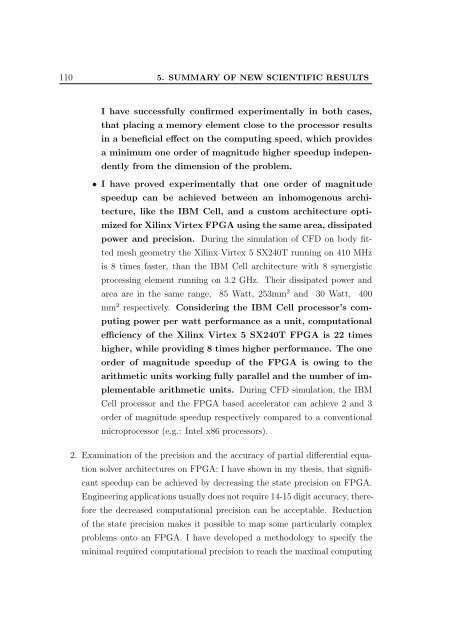PPKE ITK PhD and MPhil Thesis Classes
PPKE ITK PhD and MPhil Thesis Classes
PPKE ITK PhD and MPhil Thesis Classes
Create successful ePaper yourself
Turn your PDF publications into a flip-book with our unique Google optimized e-Paper software.
110 5. SUMMARY OF NEW SCIENTIFIC RESULTS<br />
I have successfully confirmed experimentally in both cases,<br />
that placing a memory element close to the processor results<br />
in a beneficial effect on the computing speed, which provides<br />
a minimum one order of magnitude higher speedup independently<br />
from the dimension of the problem.<br />
• I have proved experimentally that one order of magnitude<br />
speedup can be achieved between an inhomogenous architecture,<br />
like the IBM Cell, <strong>and</strong> a custom architecture optimized<br />
for Xilinx Virtex FPGA using the same area, dissipated<br />
power <strong>and</strong> precision. During the simulation of CFD on body fitted<br />
mesh geometry the Xilinx Virtex 5 SX240T running on 410 MHz<br />
is 8 times faster, than the IBM Cell architecture with 8 synergistic<br />
processing element running on 3.2 GHz. Their dissipated power <strong>and</strong><br />
area are in the same range, 85 Watt, 253mm 2 <strong>and</strong> 30 Watt, 400<br />
mm 2 respectively. Considering the IBM Cell processor’s computing<br />
power per watt performance as a unit, computational<br />
efficiency of the Xilinx Virtex 5 SX240T FPGA is 22 times<br />
higher, while providing 8 times higher performance. The one<br />
order of magnitude speedup of the FPGA is owing to the<br />
arithmetic units working fully parallel <strong>and</strong> the number of implementable<br />
arithmetic units. During CFD simulation, the IBM<br />
Cell processor <strong>and</strong> the FPGA based accelerator can achieve 2 <strong>and</strong> 3<br />
order of magnitude speedup respectively compared to a conventional<br />
microprocessor (e.g.: Intel x86 processors).<br />
2. Examination of the precision <strong>and</strong> the accuracy of partial differential equation<br />
solver architectures on FPGA: I have shown in my thesis, that significant<br />
speedup can be achieved by decreasing the state precision on FPGA.<br />
Engineering applications usually does not require 14-15 digit accuracy, therefore<br />
the decreased computational precision can be acceptable. Reduction<br />
of the state precision makes it possible to map some particularly complex<br />
problems onto an FPGA. I have developed a methodology to specify the<br />
minimal required computational precision to reach the maximal computing






![optika tervezés [Kompatibilitási mód] - Ez itt...](https://img.yumpu.com/45881475/1/190x146/optika-tervezacs-kompatibilitasi-mad-ez-itt.jpg?quality=85)









